Transportation School
-
- MarAd's Schubert: Building a Better U.S. Business Maritime Reporter, Aug 2002 #24
In part one of a two-part series, William G. Schubert, the new U.S. Maritime Administrator (MarAd) speaks with H. Clayton Cook, Jr. about the current standing and future direction of maritime activities in the United States.
Mr. Administrator, this interview is being conducted for a piece that will be published in the August 2002 issue of Maritime Reporter and Engineering News, the largest magazine of general circulation in the maritime community. So, we have a good many readers who are interested in what you are doing. Your interview will be headlined on the magazine cover. And, we are very pleased that you have agreed to speak with us today.
Cook: Would you tell our readers about yourself and life in Washington as the Maritime Administrator?
Schubert: It is great to be in Washington, serving the President of the United States. It's a great honor and opportunity that I never imagined when I graduated from the U.S. Merchant Marine Academy (Kings Point) in 1974. After I left Kings Point, I went to sea for 12 years, sailing as an officer aboard U.S.-flag vessels.
Also, I served 10 years as a commissioned officer in the United States Navy Reserve. I then worked at the Maritime Administration for nine years, spending four years in Washington (1986-1990) as an offshore industry expert advising the Maritime Administrator in policy development for the management, maintenance and liquidation of assets acquired through defaults under the Federal Ship Financing Program. The following five years (1990-1995), I served as MarAd's regional representative for all of the Agency's program interests in the southwestern region of the United States. During Operation Desert Shield/Storm, I monitored the Port Readiness Program, vessel load-out operations, and interagency planning meetings for the Port of Houston. I have dedicated my entire career to the Maritime industry. And, I believe in the Maritime Administration and in the importance of the MarAd mission Cook: Do you miss Texas?
Schubert: Of course of I miss Texas. My home is in Texas. President Bush recently said something that made a lot of sense to me. "My address may have changed, but my home remains in Texas." I was very happy in Houston with my business, International Trade & Transportation, Inc. (IT&T), however, when the President asks you to serve in his Administration, you don't say "no." My son is in college in Texas. My wife Gail is here in Washington with me.
Cook: Tell us about the business you left behind in Houston?
Schubert: At IT&T we provided transportation consulting services to ocean carriers, project exporters, freight forwarders and lending institutions. We dealt with major international infrastructure projects, which over the course of the last half dozen year aggregated over $7 billion in value, which generated over $50 million in revenues for U.S.-flag ocean carriers.
Cook: How have your experiences as a transportation transportation consultant, MarAd regional representative and sailing as a Master mariner shaped your leadership style?
Schubert: I believe that I have seen all sides of the picture, from operational to management to government.
There is one overriding issue that plagues every aspect of the U.S. maritime industry — a lack of public understanding of the importance of the U.S.
shipbuilding and the U.S.-flag merchant marine. We all need to do a better job promoting ourselves, our mission, and expressing the importance of the U.S.- flag merchant marine and U.S. shipbuilding, for protecting our economic and national security.
Cook: Many of our readers are not from the United States and may not be familiar with MarAd's mission.
Can you explain your agency's mission?
Schubert: The mission of the Maritime Administration is to promote the development and maintenance of an adequate, well-balanced United States merchant marine, sufficient to carry the Nation's domestic waterborne commerce and a substantial portion of its waterborne foreign commerce. Our merchant marine must also be capable of serving as a naval and military auxiliary in time of war or national emergency.
MarAd must also ensure that the United States enjoys adequate shipbuilding and repair services, efficient ports, effective intermodal water and land transportation systems, and reserve shipping capacity in the event of a national emergency.
Our mission is important and I hope to take it one step further by enhancing the visibility of the U.S.-flag merchant marine worldwide and making MarAd a better agency than when I arrived. MarAd is a great agency with great people who have dedicated their lives to its mission. However, we can do more as a promotional agency to support our existing U.S.-flag fleet as well as looking ahead into the future in developing a U.S.-flag presence where one does not already exist. For example, there are niche markets where the U.S.-flag can succeed, such as carriage of Export Import Bank cargoes and other government preference cargoes.
Cook: How have the events of 9/11 changed the Maritime Administration? Will MarAd be included in the new Department of Homeland Security?
Schubert: We have had a greater post 9/11 role in the area of training. At the U.S. Merchant Marine Academy we are working on developing opportunities for our graduating midshipmen who do not go to sea or cannot find jobs at sea. Our midshipmen are ideal candidates for the Transportation Security Administration because of their familiarity with the marine environment.
Also, they have already obtained training in important related areas, such as small-arms training and anti-piracy safeguards. A year at sea is already a part of their training, so they make great candidates for the new TSA and the Coast Guard.
The Global Maritime and Transportation School at the U.S. Merchant Marine Academy is being considered as a training center for port personnel. In fact, the State of Florida is sending over 20 of its law enforce enforcement personnel for port security training. The school, also known as GMATS, is a valuable resource to train port managers and other people in critical specialties who are charged with ensuring the safety and security our Nation's ports.
MarAd will remain at the Department of Transportation under the President's proposal and the Coast Guard and the Transportation Security Administration will fall under the Department of Homeland Security.
Cook: You mentioned earlier that MarAd seeks to ensure that the United States enjoys adequate shipbuilding and repair services as a part of its mission.
What do you foresee in this regard?
Schubert: Let me begin by reiterating MarAd's mission — it is absolutely essential that we maintain sufficient infrastructure to build and maintain vessels to meet our military and commercial requirements.
That means we must be certain that we are able to domestically build and repair our own vessels during peacetime and declared national emergencies.
The trends in U.S. Shipbuilding over the past twenty years has not been positive. Since the early 1980s it is estimated that shipyard employment has decreased by over 50 percent. During the same time frame, U.S.
shipyards have: • Lagged in productivity compared to other U.S.
industries, • Have not had sufficient Research and Development resources to keep pace with world shipbuilding practices, • Experienced difficulty in retraining an adequately trained supply of production workers. This is especially critical in a labor-intensive industry such as shipyard repair and construction, and • Been in the almost impossible position of competing in an international shipbuilding environment that is notoriously heavily subsidized and has significant over capacity.
So, the world shipbuilding market is such that U.S.
shipbuilding opportunities are limited.
Now, having said that, I nevertheless believe that there are existing and near-term U.S.
domestic transportation needs which will provide significant building opportunities for our U.S. commercial shipbuilders.
Cook: Would you expand on this?
Schubert: Certainly. The Jones Act and the Passenger Vessel Services Act reserve the carriage of cargo and passengers between U.S. ports to vessels built in the United States. The most important shipbuilding opportunities are those, which are resulting from the Oil Pollution Act of 1990, and the requirement for double hulled vessels in our U.S. coastwise and Gulf of Mexico services.
The OPA 90 and other petroleum related requirements should provide shipyard employment for yards across the entire spectrum of shipyard size. Of perhaps equal importance for our larger shipyards, the ocean-going container and RoRo tonnage fleets in our noncontiguous trades, Alaska, Hawaii and Puerto Rico, are going to require near term replacement. And, there may be opportunities for construction for coastwise container operations. For our smaller yards, perhaps the single most important subject matter may be vessels to meet the expanding passenger and passenger/vehicle ferry service needs.
Cook: Could you explain the importance of OPA 90 for our readers?
Schubert: OPA 90, The Oil Pollution Act of 1990, requires the replacement of all single hulled tank vessels used in the U.S. petroleum crude and product carrier and related trades in five-year intervals at the end of 2005, 2010 and 2015. The current U.S. flag tanker fleet is comprised of approximately 100 vessels; roughly two-thirds product tankers, and one third crude carriers.
Only ten of these vessels are double hulled and of recent construction.
The remaining 90 plus vessels will be phased out at the five-year intervals that I've mentioned. The replacement of Alaska crude carrier tonnage by the major energy companies involved in North Slope production is well underway.
The replacement of product carriers, the greater number of which are owned by independent operators, has hardly begun.
Cook: What about the "non-contiguous trades"? Would you explain the importance of these?
Schubert: The container and RoRo vessels of our U.S. citizen carriers serving Alaska, Hawaii and Puerto Rico are old and inefficient. While none of these trades is experiencing rapid growth, the involved vessels are expensive to operate and increasingly expensive to maintain. Replacement build buildings have been gotten underway. Totem Ocean Trailer Express, which serves Alaska, will be replacing three 1970's vintage RoRo vessels with two newly commissioned 600 trailer vessels now being built at National Steel & Shipbuilding Company. Matson Navigation Company, the predominant carrier in the Hawaiian trade, has recently announced that it will purchase two new 35,000- dwt container vessels from the Kvaerner Philadelphia Shipyard. If Kvaerner is successful with this delivery, it appears that Matson may be prepared to move forward with Kvaerner for two more vessels of the same Kvaerner design. If so, this would certainly a major step forward for everyone involved in this transaction and for U.S. shipbuilding more generally.
Cook: I see that we are running out of time, what do you believe MarAd should do to support the shipyard and ship repair industry?
Schubert: MarAd is committed 100 percent to working with the Navy, our U.S. shipbuilding and repair yards, labor, our U.S. commercial vessel operators, and Congress to develop a unified long-term strategy to maintain our shipyard capacity.
We must address the issues of shipyard productivity, modern shipyard infrastructure, R&D investment, manning and training sufficient skilled workers. To the extent that we expect to be concerned with building for export, we may need to address issues related to international business practices involving subsidies.
On the commercial side, MarAd will work to identify and assist our U.S.
shipyards in opportunities in our domestic trade. Everyone agrees that our shipyards need to identify vessel designs that they can build in series in sufficient numbers to reach adequate economies of scale. The Kvaerner Philadelphia Shipyard may be headed in that direction with its container vessel design. 1 believe this can be done with other vessel designs and I am up for the chal- lenge.
Cook: I have one more question.
There has been a great deal of concern expressed about port security focusing on non-citizen owned foreign flag vessels and their cargoes entering our ports.
However, I have not read anything concerning the monitoring of movements of U.S.-flag vessels entering or already in our U.S. ports that might be chartered to non-citizens. I see that the House Armed Services Committee report accompanying the FY 2003 MarAd authorization urges MarAd to review its post 1992 policy of "blanket" approval of "time charters and other forms of temporary use agreements" to non-citizens and requests a report back to the Committee by November 1. Would you comment?
Schubert: Yes. We believe that these charters to non-citizens present a potentially serious problem. MarAd has had the problem under study for sometime.
The House Committee report request comes, as it were, mid-stream in MarAd's work on the problem. The world is a different place today from what it was in 1992. A time charterer determines what cargoes will be loaded and discharged, and directs the vessel's schedule and its ports of call. We are concerned. And, we will wish to have the benefit of the Maritime community's thinking on the problem. We will be publishing a notice in the Federal Register inviting public comment through written submissions.
About the Author H. Clayton Cook, Jr., B.S. Princeton University, LLB The University of Virginia. Mr. Cook served as General Counsel of the U. S. Maritime Administration from 1970 to 1973, where he was responsible for the implementation of the Merchant Marine Act of 1970, and the drafting of the Federal Ship Financing Act of 1972. Upon completing his government service, Mr. Cook joined Cadwalader, Wickersham & Taft as the partner responsible for the development of that firm's Washington Maritime practice. Mr. Cook continues his law practice today as Counsel to Bastianelli, Brown & Kelley, Chartered, in that firm's Washington, D.C.
offices. He is also a partner in Management & Transportation Associates, Inc., a management consulting firm based in Essex, Conn. Mr.
Cook's email address is PlimsollDC@ aol.com.
-
- Domestic Maritime Policy: It's Not Business as Usual Maritime Logistics Professional, Nov/Dec 2017 #19
of a surprise announcement, Buzby also told MLPro, “I’m anxious to get GMATS going again.” GMATS was the continuing education Global Maritime and Transportation School that was shut down suddenly by the Department of Transportation in 2012 as of July 2012. Back then, GMATS employed 30 full-time employees,
-
 )
March 2024 - Marine Technology Reporter page: 25
)
March 2024 - Marine Technology Reporter page: 25Auerbach explained that ideally, “one ? ed layers of geothermal activity,” noted changes over an area of 8,000 km2. They would have both instruments: seismom- Skett, “and the change in salinity and dis- found up to seven km3 of displaced ma- eters to detect and locate subsurface ac- solved particles for
-
 )
April 2024 - Maritime Reporter and Engineering News page: 43
)
April 2024 - Maritime Reporter and Engineering News page: 43restraint on any haste to participation included a "Transition in er systems would include an outline reform CII until a better understanding Transportation" panel session covering of standards for secure data exchange, of the impact of changing vessel speeds how to reduce shipping’s carbon foot-
-
 )
April 2024 - Maritime Reporter and Engineering News page: 25
)
April 2024 - Maritime Reporter and Engineering News page: 25RADM PHILIP SOBECK, MILITARY SEALIFT COMMAND Photo by Brian Suriani USN Military Sealift Command From a global supply chain perspective, What makes MSC so vital to the we’ve learned a lot about dealing with Navy’s ? eet and our military disruptions. COVID delivered a big forces around the world? wake-up
-
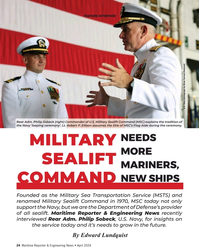 )
April 2024 - Maritime Reporter and Engineering News page: 24
)
April 2024 - Maritime Reporter and Engineering News page: 24assumes the title of MSC’s Flag Aide during the ceremony. NEEDS MILITARY MORE SEALIFT MARINERS, NEW SHIPS COMMAND Founded as the Military Sea Transportation Service (MSTS) and renamed Military Sealift Command in 1970, MSC today not only support the Navy, but we are the Department of Defense’s provider
-
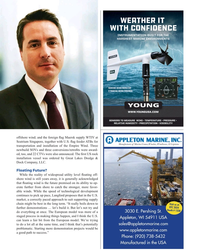 )
April 2024 - Maritime Reporter and Engineering News page: 23
)
April 2024 - Maritime Reporter and Engineering News page: 23offshore wind; and the foreign ? ag Maersk supply WTIV at Seatrium Singapore, together with U.S. ? ag feeder ATBs for transportation and installation of the Empire Wind. Three newbuild SOVs and three conversions/retro? ts were award- ed, too, and 22 CTVs were also announced. The ? rst US rock installa
-
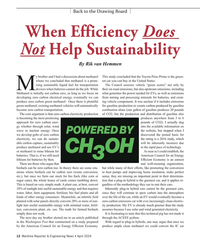 )
April 2024 - Maritime Reporter and Engineering News page: 12
)
April 2024 - Maritime Reporter and Engineering News page: 12Prius Prime is the green- where we concluded that methanol is a prom- est car you can buy in the United States. ising sustainable liquid fuel for transportation The Council assesses vehicle “green scores” not only by Mdevices when batteries cannot do the job. While their on-road emissions, but also upstream
-
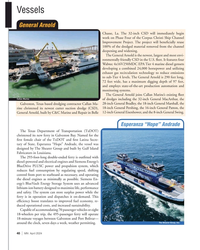 )
April 2024 - Marine News page: 40
)
April 2024 - Marine News page: 40, built by C&C Marine and Repair in Belle 12-inch General Eisenhower, and the 8-inch General Swing. Esperanza “Hope” Andrade The Texas Department of Transportation (TxDOT) christened its new ferry in Galveston Bay. Named for the ? rst female chair of the TxDOT and ? rst Latina Secre- tary of State, Esperanza
-
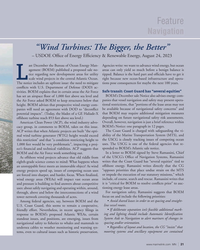 )
April 2024 - Marine News page: 21
)
April 2024 - Marine News page: 21the vi- ACP writes that when Atlantic projects are built “the opti- mal wind turbine generator (WTG) height would exceed ability of the Marine Transportation System (MTS), and this restriction” and that “a condition restricting height to the USCG is closely tracking issues of competing ocean uses
-
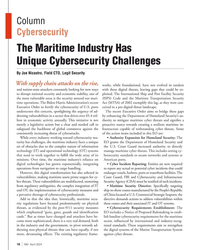 )
April 2024 - Marine News page: 18
)
April 2024 - Marine News page: 18of ploited. The International Ship and Port Facility Security the most vulnerable areas is the security around our mari- (ISPS) Code and the Maritime Transportation Security time operations. The Biden-Harris Administration’s recent Act (MTSA) of 2002 exemplify this lag, as they were con- Executive Order to
-
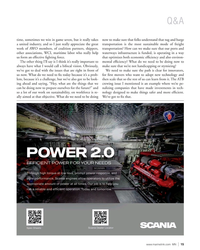 )
April 2024 - Marine News page: 15
)
April 2024 - Marine News page: 15seven, but it really takes now to make sure that folks understand that tug and barge a united industry, and so I just really appreciate the great transportation is the most sustainable mode of freight work of AWO members, of coalition partners, shippers, transportation? How can we make sure that our ports
-
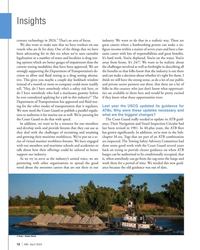 )
April 2024 - Marine News page: 12
)
April 2024 - Marine News page: 12modalities that have been approved. We are the challenges involved as well as forthright in describing all strongly supporting the Department of Transportation’s de- the bene? ts so that folks know that the industry is out there cision to allow oral ? uid testing as a drug testing alterna- and can make
-
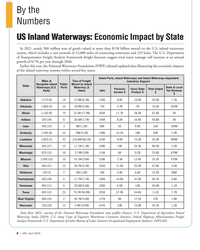 )
April 2024 - Marine News page: 8
)
April 2024 - Marine News page: 8on the U.S. inland waterways system, which includes a vast network of 12,000 miles of connecting waterways and 219 locks. The U.S. Department of Transportation Freight Analysis Framework freight forecasts suggest total water tonnage will increase at an annual growth of 0.7% per year through 2040. Earlier
-
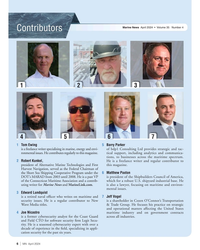 )
April 2024 - Marine News page: 6
)
April 2024 - Marine News page: 6naval of? cer who writes on maritime and 7 Jeff Vogel security issues. He is a regular contributor to New is a shareholder in Cozen O’Connor’s Transportation Wave Media titles. & Trade Group. He focuses his practice on strategic and operational matters affecting the United States 4 Joe Nicastro
-
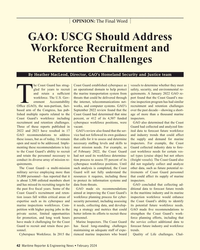 )
February 2024 - Maritime Reporter and Engineering News page: 42
)
February 2024 - Maritime Reporter and Engineering News page: 42meet gled for years to recruit an operational domain to help protect safety, security, and environmental re- and retain a suf? cient the marine transportation system from quirements. A January 2022 GAO re- workforce. The U.S. Gov- threats that could be delivered through port found that the Coast Guard’s
-
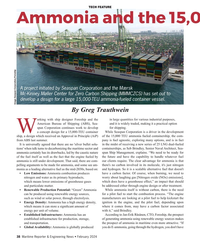 )
February 2024 - Maritime Reporter and Engineering News page: 38
)
February 2024 - Maritime Reporter and Engineering News page: 38, CTO, Foreship, the prospect established infrastructure for production, storage, of generating ammonia using renewable energy sources makes and transportation. the prospect of ammonia in maritime even more attractive. “If • Global Availability: Ammonia is globally produced you do E-ammonia, going
-
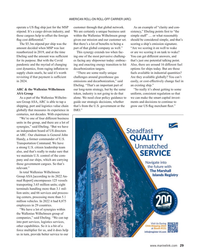 )
February 2024 - Maritime Reporter and Engineering News page: 29
)
February 2024 - Maritime Reporter and Engineering News page: 29synergies,” said Ebeling. “But we have an independent board of US directors at ARC. Our chairman is General John Handy, a former commander of U.S. Transportation Command. We have a strong U.S. citizen leadership team also, and that’s really to make sure that we maintain U.S. control of the com- pany and
-
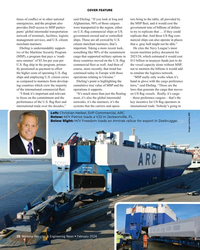 )
February 2024 - Maritime Reporter and Engineering News page: 28
)
February 2024 - Maritime Reporter and Engineering News page: 28cost the provides DoD access to MSP partici- were transported to the region, either government tens of billions of dollars pants’ global intermodal transportation on U.S.-? ag commercial ships or US. to try to replicate that … if they could network of terminals, facilities, logistic government owned
-
 )
February 2024 - Maritime Reporter and Engineering News page: 22
)
February 2024 - Maritime Reporter and Engineering News page: 22R&D MATT HART Matt Hart, Manager & Platform Leader, Marine & Stationary Power Systems, Wabtec, offers insights on how the megatrends of decarbonization, energy transition and autonomy all inspire Image courtesy Wabtec and impact the marine power solutions from Wabtec. By Greg Trauthwein Matt, to start
-
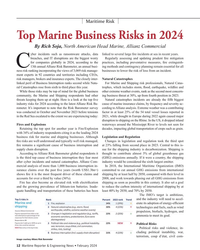 )
February 2024 - Maritime Reporter and Engineering News page: 12
)
February 2024 - Maritime Reporter and Engineering News page: 12waterways around the Mississippi River to levels not seen for Retaining the top spot for another year is Fire/Explosion decades, impacting global transportation of crops such as grain. with 34% of industry respondents citing it as the leading 2024 business risk for marine and shipping businesses. Although
-
 )
February 2024 - Maritime Reporter and Engineering News page: 11
)
February 2024 - Maritime Reporter and Engineering News page: 11, and as long And yes, Ladies and Gentlemen, we will have entered a as there are lots of waterfront delivery points, the delivery can bene? cial transportation cycle with the ability to achieve be done in smaller moving units. Those smaller moving units massive system wide ef? ciency increases. But
-
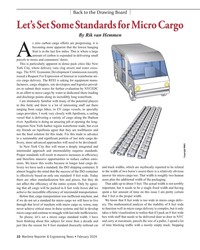 )
February 2024 - Maritime Reporter and Engineering News page: 10
)
February 2024 - Maritime Reporter and Engineering News page: 10be packed in 8 feet wide boxes did we important, but it needs to be a single ? xed width and having achieve the incredible ef? ciency of intermodal transportation. spent a fair amount of time on this issue I am pretty certain Before that, cargo transportation was inef? cient mayhem, and that 5 feet is
-
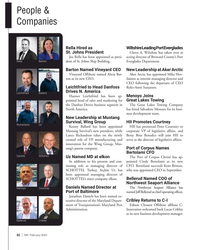 )
February 2024 - Marine News page: 42
)
February 2024 - Marine News page: 42Jeff Bellerud as chief operating of? cer. Jonathan Daniels has been named ex- ecutive director of the Maryland Depart- Cribley Returns to C-I ment of Transportation’s Maryland Port Edison Chouest Offshore af? liate C- Administration. Innovation welcomed back Lucas Cribley as its new business development
-
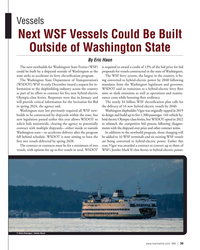 )
February 2024 - Marine News page: 39
)
February 2024 - Marine News page: 39seeks to accelerate its ferry electri? cation program. The WSF ferry system, the largest in the country, is be- The Washington State Department of Transportation’s ing converted to hybrid-electric power by 2040 following (WSDOT) WSF in early December issued a request for in- mandates from the Washington
-
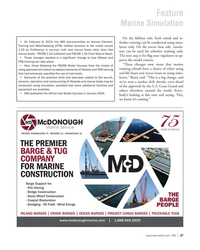 )
February 2024 - Marine News page: 37
)
February 2024 - Marine News page: 37Feature Marine Simulation On the lifeboat side, both initial and re- • On February 9, 2023, the IMO sub-committee on Human Element, fresher training can be conducted using simu- Training and Watchkeeping (HTW) rati? ed revisions to the model course lators only. On the rescue boat side, simula- 1.23 on
